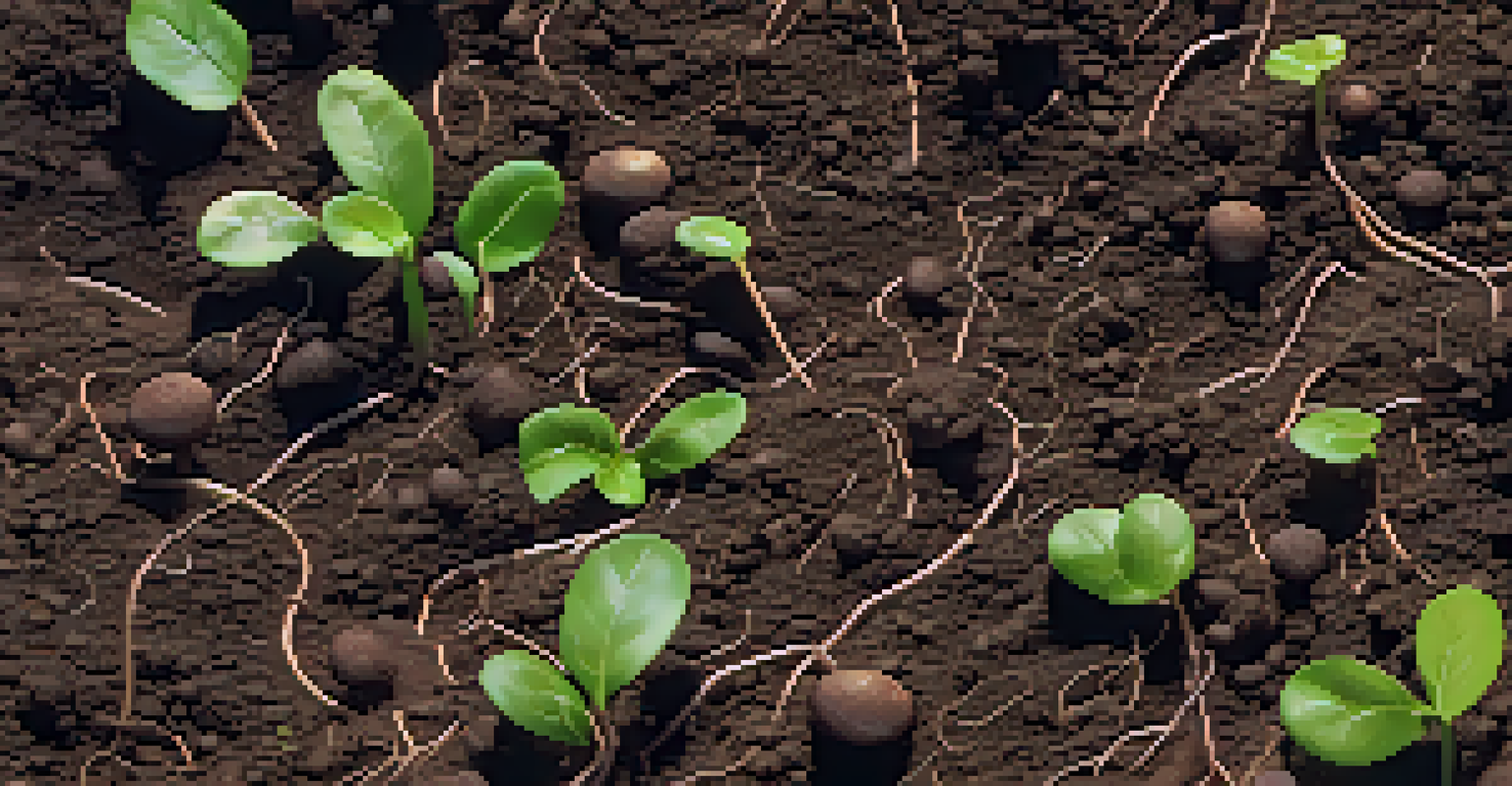Understanding Carbon Sequestration: How Plants Capture CO2

What is Carbon Sequestration and Why Does It Matter?
Carbon sequestration is the process by which carbon dioxide (CO2) is captured and stored, helping to reduce greenhouse gases in the atmosphere. This is crucial for combating climate change, as excess CO2 contributes to global warming. By understanding how this process works, we can appreciate the vital role that plants play in maintaining ecological balance.
The Earth does not belong to us: we belong to the Earth.
Plants, particularly trees, absorb CO2 during photosynthesis and convert it into oxygen and glucose. This natural cycle not only sustains plant life but also supports all living organisms on Earth. By sequestering carbon, plants help to mitigate climate change and improve air quality, making them invaluable to our planet's health.
In essence, carbon sequestration is nature's way of regulating atmospheric CO2 levels. With the increasing threat of climate change, promoting and protecting plant life is more important than ever. This process exemplifies the interconnectedness of ecosystems and highlights the significance of plants in ensuring a sustainable future.
The Process of Photosynthesis: Plants at Work
Photosynthesis is the cornerstone of carbon sequestration in plants. During this process, plants take in sunlight, water, and CO2 to create energy-rich glucose and release oxygen as a byproduct. This is not just a simple chemical reaction; it’s a complex series of steps that showcases the remarkable abilities of plants.

In essence, photosynthesis allows plants to capture atmospheric CO2 and transform it into organic matter, such as leaves, stems, and roots. This stored carbon can remain in plants for years, acting as a natural reservoir. Moreover, when plants die and decompose, the carbon can be stored in the soil, providing long-term benefits to the environment.
Nature's Role in Carbon Capture
Plants play a crucial role in carbon sequestration by absorbing CO2 during photosynthesis, thereby helping to mitigate climate change.
Understanding photosynthesis helps us appreciate the importance of preserving plant life. Each tree or plant contributes to a larger system that supports carbon sequestration, making it imperative that we protect our forests and green spaces. By promoting healthy ecosystems, we can enhance the planet's ability to capture CO2.
Different Types of Carbon Sequestration in Nature
Carbon sequestration occurs through various natural processes, broadly classified into terrestrial and oceanic sequestration. Terrestrial sequestration takes place in forests, grasslands, and wetlands, where plants capture CO2 and store it in biomass and soil. This is where terrestrial ecosystems shine, acting as powerful carbon sinks.
We won't have a society if we destroy the environment.
On the other hand, oceanic sequestration involves the absorption of CO2 by oceans, where marine plants and phytoplankton play crucial roles. These organisms also perform photosynthesis, capturing CO2 and storing it in ocean sediments. Both processes are vital for maintaining balance in our planet's carbon cycle.
Recognizing the different types of carbon sequestration illuminates the diverse ways nature works to combat climate change. Each ecosystem contributes uniquely, showcasing the importance of biodiversity. Protecting these varied environments not only enhances carbon capture but also strengthens ecological resilience.
The Role of Soil in Carbon Sequestration
Soil plays an often-overlooked but essential role in carbon sequestration. As plants grow, they transfer carbon to the soil through roots and organic matter. This process enriches the soil, making it healthier and more productive while simultaneously sequestering carbon.
Healthy soils can store significant amounts of carbon, often more than the atmosphere itself. Practices such as cover cropping, reduced tillage, and organic farming enhance soil carbon storage. By adopting these methods, we can improve soil health while effectively capturing more CO2.
Soil's Importance in Sequestration
Healthy soils can store significant amounts of carbon, and sustainable agricultural practices can enhance this crucial process.
Understanding the connection between soil and carbon sequestration underscores the importance of sustainable agricultural practices. By focusing on soil health, we not only improve crop yields but also contribute to climate change mitigation. It’s a win-win for both farmers and the planet.
The Impact of Deforestation on Carbon Sequestration
Deforestation poses a significant threat to carbon sequestration efforts. When forests are cleared, the carbon stored in trees is released back into the atmosphere, contributing to increased CO2 levels. This creates a vicious cycle, where loss of vegetation leads to climate change, further impacting plant life.
Additionally, the removal of trees diminishes the planet's capacity to capture carbon. Forests act as natural carbon sinks, and their destruction means losing a critical tool in the fight against climate change. The consequences extend beyond carbon capture, affecting biodiversity and local climates.
Addressing deforestation is essential for enhancing carbon sequestration. By promoting sustainable forestry practices and reforestation efforts, we can restore damaged ecosystems and bolster the planet's ability to absorb CO2. Protecting our forests is not just an environmental issue; it’s a vital step towards a sustainable future.
The Role of Urban Green Spaces in Carbon Capture
Urban areas often overlook the potential of green spaces in carbon sequestration. Parks, gardens, and green roofs can effectively capture CO2 while providing numerous other benefits, such as improved air quality and enhanced mental well-being. Every tree planted in a city contributes to carbon capture efforts.
Moreover, urban greenery helps mitigate the heat island effect, where city temperatures soar due to concrete and asphalt. This cooling effect can reduce energy consumption for air conditioning, further lowering carbon emissions. It’s a brilliant example of how nature can work alongside urban development.
Urban Green Spaces Matter
Integrating green spaces in urban areas can boost carbon sequestration efforts while providing additional benefits like improved air quality.
Encouraging the integration of green spaces in cities can significantly enhance carbon sequestration efforts. By investing in community gardens and urban forestry programs, we can transform our cities into carbon sinks. This not only addresses climate change but also fosters healthier, more vibrant communities.
The Future of Carbon Sequestration: Innovation and Action
As we look to the future, innovative approaches to carbon sequestration are emerging. Scientists are exploring methods like biochar, which involves converting organic materials into a stable form of carbon that can be added to soil. This technique not only sequesters carbon but also enhances soil fertility.
Additionally, advancements in technology, such as carbon capture and storage (CCS), offer promising solutions. These methods capture CO2 from industrial sources and store it underground, preventing it from entering the atmosphere. While still in development, they represent a significant step forward in the fight against climate change.

Ultimately, a multifaceted approach is necessary to tackle the climate crisis effectively. Combining natural processes with innovative technologies can enhance our carbon sequestration efforts. By understanding and supporting these initiatives, we can all play a role in building a sustainable future.